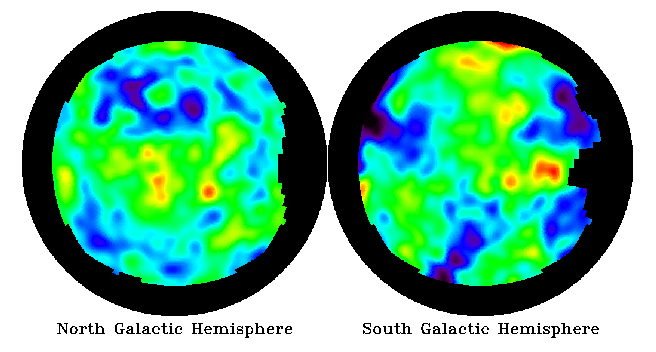
[Image credit: NASA, Cosmic Background Explorer]
Why, however, do we see a Cosmic MICROWAVE Background? At the era of recombination (the time when neutral atoms formed and the universe became transparent), the temperature was T = 3000 Kelvin (about the surface temperature of an M star, such as Betelgeuse). The wavelength of maximum emission was then 970 nanometers, in the infrared. When the universe first became transparent, therefore, observers would have seen a Cosmic INFRARED Background. However, since the era of recombination, the universe has expanded by a factor of 1100, stretching lambdamax from 970 nanometers to 1 millimeter (that is, 1,000,000 nanometers). This is equivalent to cooling the temperature of the Cosmic Background from 3000 Kelvin to 2.725 Kelvin.
The discovery of the Cosmic Microwave Background in 1965 provided strong support for the Big Bang theory. So far, we've encountered three bits of evidence to support the Big Bang theory.
By looking at the Cosmic Microwave Background, we are looking at the surface of the opaque ionized ``fog'' that filled the early universe. The Cosmic Microwave Background contains interesting information about what the universe was like at the tender age of 300,000 years old (only 1/50,000 its present age).
Getting a good look at the Cosmic Microwave Background requires putting a satellite above the Earth's moist atmosphere. (Water absorbs microwaves; this is convenient if you want to heat food in a microwave oven but is a great nuisance if you want to detect microwaves from space.) At the present moment (March 2003), the Wilkinson Microwave Anisotropy Probe is at the Earth's L2 point, far beyond the Moon, mapping the sky in microwaves. The first data release (covering one year's mapping) occurred in February 2003.
A good look at the entire sky reveals some interesting irregularities in the Cosmic Microwave Background. For instance, the temperature of the Cosmic Microwave Background is very slightly higher on one half of the sky (toward the constellation Leo) than on the other half (toward Aquarius). This is the result of a Doppler shift. The Microwave Anisotropy Probe is moving around the Sun; the Sun is orbiting the center of our galaxy; our galaxy is falling toward the Andromeda Galaxy; the Local Group (containing both our galaxy and the Andromeda Galaxy) is being pulled toward the Virgo Cluster; the Local Supercluster (containing both the Local Group and the Virgo Cluster) is being tugged toward the Hydra-Centaurus Supercluster. As a net result of all these motions, the Microwave Anisotropy probe is moving in the direction of Leo at a few hundred kilometers per second. The microwaves coming from the direction of Leo are slightly blueshifted to higher temperatures; the microwaves coming from the opposite direction are slightly redshifted to lower temperatures.
After subtracting the Doppler shift due to the satellite's motion through space, the Cosmic Microwave Background still shows hot spots and cold spots, about one degree across (twice the width of the full Moon). These observed temperature fluctuations are the result of density fluctuations in the early universe, at the era of recombination when the universe became transparent. Regions that were slightly compressed at that time had higher density and higher temperature. (Remember, gas becomes hotter as it is compressed. This applies to a gas made of photons as well as to a gas made of atoms.)
If the universe had LARGE density fluctuations one million years ago, then the cosmic microwave background would show LARGE temperature fluctuations today. However, the observations of the Microwave Anisotropy Probe reveal that the hot spots are only 0.0001 Kelvin hotter than the cold spots (that is, only a few parts per 100,000). This indicates that the density fluctuations were small in amplitude when the universe became transparent. The hot spots, representing regions very slightly denser than their surroundings, have grown with time to become vast dense superclusters, like those we see around us today. Remember the universal law: The rich get richer. Regions that were only slightly denser than average back then have grown under the influence of gravity until they are much denser than average now.

[Image credit: NASA, Cosmic Background Explorer]
Updated: 2003 Mar 4
Copyright © 2003, Barbara Ryden